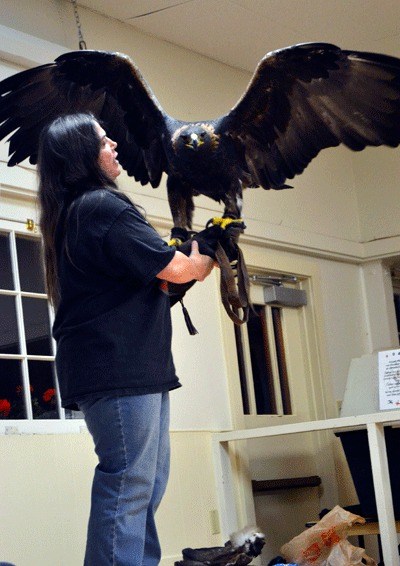Kestrel SkyHawk swooped in with bald and golden eagles for the public to see.
SkyHawk, the education director at the Sarvey Wildlife Care Center, held a presentation with live raptors Thursday, Oct. 10 at the Coupeville Recreation Hall. More than 80 people attended the event, which was hosted by the Whidbey Audubon Society.
Enthusiastic crowd members showed up early to secure a great perch for birdwatching. A few even brought their telephoto lenses to capture the moment.
“You’re going to be able to see boogers in their nostrils,” SkyHawk joked with them.
Sarvey Wildlife Care Center is located in Arlington, and it is the only wildlife ambulance service available in the state. Its mission is to save animal lives and return them to their native habitat. The center also educates the public on different species, providing more than 120 programs annually. So far the center has helped approximately 3,494 animals this year.
“That means from the smallest humming bird to an elk we had last year,” SkyHawk said.
Jill Hein, a Whidbey Audubon Society member, volunteered at the center for 13 years and worked with SkyHawk.
“She’s always been there for the birds,” Hein said, “she’s their best friend.”
For 31 years SkyHawk has been rehabilitating animals, and been at the center for 24 years.
“It’s amazing to have an animal that is devastatingly incapacitated, have it stay at the center and make it well,” SkyHawk said.
David Storm, Sarvey’s rescue technician and part of SkyHawk’s education team, said he had the opportunity to care for some baby bald eaglets that were released back into the wild, and it was one of the most rewarding experiences he’s had there.
When it came time to show the eagles to the crowd, SkyHawk put on two handlers gloves on the same hand because of how powerful their feet are.
The golden eagle, Hu Iyake, was brought to the center less than 14 years ago. She was found in Grand Coulee and at first they thought she was dead, SkyHawk said. She was diagnosed with avian trichomoniasis, which means the bottom part of her beak keeps growing. Every eight weeks they have to manage that growth.
If they didn’t, she wouldn’t be able to close it and she wouldn’t be able to eat.
Storm brought out Askate, a bald eagle that fell out of a nest and fractured her wing. She’s 7 years old and has been at the center for six years. She is unable to fly.
“We do not keep any bird that can be released. We’re not a zoo,” SkyHawk said.
Both eagles only have one handler. SkyHawk takes care of Hu Iyake, and Storm watches over Askate. To gain Askate’s trust, Storm said it took a lot of patience.
“Eagles are one-person birds, and it’s hard to get them to trust you,” Storm said.
“For six months I went home bleeding every week. It’s one of those commitments you really have to make.”
Both Storm’s and SkyHawk’s efforts have paid off and could be seen by the crowd by handling the raptors within inches of their faces.
“She’s 12 pounds but feels like a 120 after a while,” SkyHawk.
Over the years, Storm and SkyHawk have bonded with their raptors. They can tell when they’re excited to see them, when their upset at the maintenance guys making too much noise, and if they’re hungry.
SkyHawk also informed people on the protocol for finding an injured animal.
The first mistake people often make is interfering when it isn’t necessary.
For example, SkyHawk explained, the center could receive a call about an injured hawk on the side of the road, when in fact, it was protecting its prey from other predators.
If the animal is injured, make sure to grab a blanket, gloves, and others to help you, SkyHawk said. Then corral it, cover it with a blanket, and pick it up with gloves. It then needs to go into some sort of container, such as a cardboard box, and be taken to licensed rehabilitation center within 24 hours.



